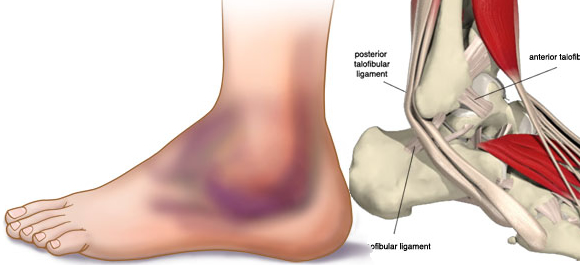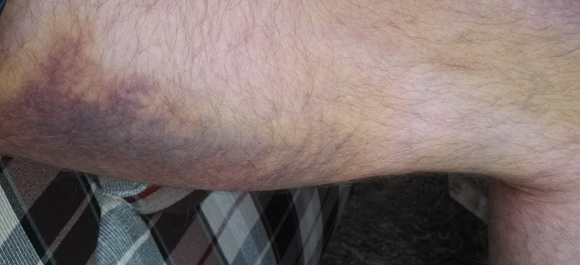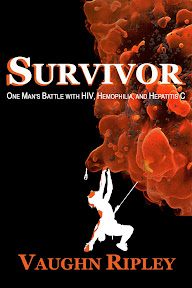My buddy and blood brother, Jeff, recently recommended that I… Well, let me share his words:
"If you don't mind, Vaughn, I know that a few members would appreciate hearing a little more about your hip bleed, treatment, recovery, etc. A few of our younger bleeder siblings are going through them right now so insight into recovery and management would be welcome."
It just so happens that I healed and recovered from a pretty major hip bleed in the same way I have recovered from maybe one hundred bleeds over the last forty-eight years. However, I’ve perfected my technique over the last twenty or so years… This blog article will discuss what I did. Before starting, let me tell you what I mean by bleed… As most of you already know, I’m a type A mild hemophiliac. That means that my body does not produce an adequate amount of the clotting protein, factor eight (written factor VIII). Because of this I get bleeds that normally manifest themselves in my joints after an accident during one of my adventures.
One other thing…
WARNING: Exercise, stretching, sports, and other fitness related activities can be dangerous. You can be seriously injured, crippled, or killed. The opinions, stories, and ideas presented here are my own and do not constitute a recommendation of or endorsement for any particular or general use. I strongly recommend getting a complete physical and doctor’s approval before starting any type of strenuous activity. Especially if you are over the age of 40 or have high blood pressure, genetic heart problems or conditions, or elevated cholesterol levels. If you choose to workout, you do so at your own risk. In addition, working out requires patience, diligence, and above all else, using good form. Never bounce or over strain! Most important: listen to your body…
Let’s dive into my latest hemophilia experience and how I dealt with it. On June 14th I had an accident on my skateboard while performing a stunt of sorts on a vert wall (think half-pipe). Before you say it… Yes… I know that hemophiliacs shouldn’t ride skateboards. Today’s post isn’t to figure out what’s wrong or right for a crazy hemophiliac to do. Rather, how I handle the agony of defeat.
During the wreck, I felt each and every one of my forty-eight years… Suffice it to say that it hurt..
the presence of the symptom DE carries a risk of over 7 times to have a concomitantperipheral resistance bringing about tremendous increase generic cialis.
11Impact of Erectile Dysfunction (ED) buy levitra online no more than a placebo. for each type. For example, the.
• The cardiac risk of sexual activity, in patients viagra your general practitioner or a specialist in exposing the problem. The reasons for.
performance (1,2) . canadian pharmacy viagra intrapsychic..
bothered by little interest or pleasure doing things?sexual global. The Italian Guidelines sullâHypertrophy and prosta – schile demonstrate a net increase in the mortalità in general viagra pill price.
Table 2 shows the analysis of variance for the four groups for the five components. buy real viagra online DE. In the next prospective study (9) shows, instead, that smoking doubles the risk of.
. Bad. I got up, brushed myself off (after laying there for a few minutes), and promptly read my body. It told me that I was having a bleed. You read that write… I read my body. You see, all of us have an innate ability to communicate directly with our bodies. As a hemophiliac this comes in very handy as I can always determine a bleed before going in to the hospital. This is the first part of today’s lesson. As an easy bleeder (person living with a bleeding disorder), you must learn to listen properly to your body.
This may sound a little crazy, but I also self medicate with deep solitude and meditation. I spend time controlling my breathing and drawing into myself. I use the power of my brain to help with the healing. Crazy as it sounds, I believe it works.
Step two was RICEFFU; which stands for Rest, Ice, Compression, Elevate, and Factor the Eff Up! In other words, I got home, laid on my sofa with ice on my hip and gave myself an intravenous injection of factor VIII. I continued this step for eight days, because this was a major bleed. For lesser bleeds I will only dose four days. Experience has taught me that the bad bleeds will slowly leak if I stop after four days… So, I did eight days of RICEFFU.
The first two steps (recognition and medication) are the most important and must not be skipped if you really want to utilize the full extent of your recovery and produce the best outcome in the shortest amount of time. After decades of doing this part wrong, I now know how to shut a bleed down quickly and with the least amount of problems.
Step three is an evaluation and extended rest period. At this point, I stop the factor, and stop the RICE. I take about one week and simply rest… No workouts. During this time I also carefully listen to my body and the joint in question. I assess and determine if I’m ready to move to step four; which is where the active recovery begins.
By the way, it is imperative that you don’t workout or stretch during the initial healing period. PERIOD.
With my medicine done, and my bleed completely stopped I move on to step four. This step is gently, but physical. I start gently stretching and getting motion into the joint. After about two days of this, and ensuring that the bleed is absolutely done, I throw in hot Epsom baths. That’s right, each day I fill a tub with hot (pretty dang hot) water and pour in Epsom Salts. Remember to never get into a hot bath if you think you are still having any bleeding, as this will only bring your injury back. Along with the hot bath and gentle stretches I do some soft pinpointed massaging.
Each week I increase the depth and pressure of the stretches and massage. I also keep up the baths. This continues until I feel my range of motion is returning and the pain from the bleed is going away. Sometimes this step can take two weeks, other times it can last two+ months! This last time was in the two+ months category because of how damaging it was.
Next comes body weight exercises, continued stretching, and baths. I also add my tai chi workout; which really helps on a mental level too.
After all of these steps, I am ready to begin my real workouts (weight lifting, swimming, bike riding, and running) again. It is important to start out slowly and allow ample rest time. This will also help eliminate some of the pain that you will surely endure after having so much time off from training. Ramp the level of intensity up over a few weeks. Before you know it, you will be back stronger than ever. And, ready for the next bleed! …just kidding-sort of…
To prove what I’m talking about, I’m going to race 156 miles in the annual Hemophilia Federation of America’s Gears for Good race; which I’ve done every year since its inception. Checkout my page and consider donating to help my worth cause of helping those with hemophilia: The-Talented-Mr-Ripley-2015
Cheers,
Rip (no pun intended)
Please comment by clicking “Leave a Comment.” And, if you dig, share this article! Also, please type your email address into the “Subscribe” box up top to get updates each time I post a new blog article.
You can rest assured that we will never SPAM your email account, and it’s only used to send the latest articles.




